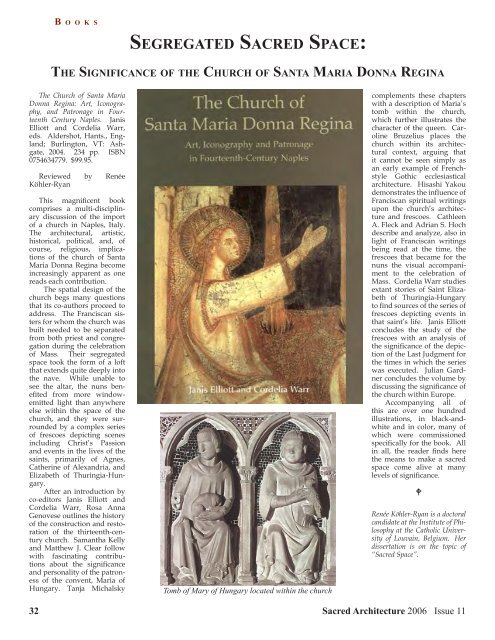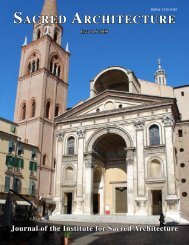Download Issue PDF - The Institute for Sacred Architecture
Download Issue PDF - The Institute for Sacred Architecture
Download Issue PDF - The Institute for Sacred Architecture
Create successful ePaper yourself
Turn your PDF publications into a flip-book with our unique Google optimized e-Paper software.
B O O K S<br />
<strong>The</strong> Church of Santa Maria<br />
Donna Regina: Art, Iconography,<br />
and Patronage in Fourteenth<br />
Century Naples. Janis<br />
Elliott and Cordelia Warr,<br />
eds. Aldershot, Hants., England;<br />
Burlington, VT: Ashgate,<br />
2004. 234 pp. ISBN<br />
0754634779. $99.95.<br />
Reviewed by Renée<br />
Köhler-Ryan<br />
This magnificent book<br />
comprises a multi-disciplinary<br />
discussion of the import<br />
of a church in Naples, Italy.<br />
<strong>The</strong> architectural, artistic,<br />
historical, political, and, of<br />
course, religious, implications<br />
of the church of Santa<br />
Maria Donna Regina become<br />
increasingly apparent as one<br />
reads each contribution.<br />
<strong>The</strong> spatial design of the<br />
church begs many questions<br />
that its co-authors proceed to<br />
address. <strong>The</strong> Franciscan sisters<br />
<strong>for</strong> whom the church was<br />
built needed to be separated<br />
from both priest and congregation<br />
during the celebration<br />
of Mass. <strong>The</strong>ir segregated<br />
space took the <strong>for</strong>m of a loft<br />
that extends quite deeply into<br />
the nave. While unable to<br />
see the altar, the nuns benefited<br />
from more windowemitted<br />
light than anywhere<br />
else within the space of the<br />
church, and they were surrounded<br />
by a complex series<br />
of frescoes depicting scenes<br />
including Christ’s Passion<br />
and events in the lives of the<br />
saints, primarily of Agnes,<br />
Catherine of Alexandria, and<br />
Elizabeth of Thuringia-Hungary.<br />
After an introduction by<br />
co-editors Janis Elliott and<br />
Cordelia Warr, Rosa Anna<br />
Genovese outlines the history<br />
of the construction and restoration<br />
of the thirteenth-century<br />
church. Samantha Kelly<br />
and Matthew J. Clear follow<br />
with fascinating contributions<br />
about the significance<br />
and personality of the patroness<br />
of the convent, Maria of<br />
Hungary. Tanja Michalsky<br />
SEGREGATED SACRED SPACE:<br />
THE SIGNIFICANCE OF THE CHURCH OF SANTA MARIA DONNA REGINA<br />
Tomb of Mary of Hungary located within the church<br />
complements these chapters<br />
with a description of Maria’s<br />
tomb within the church,<br />
which further illustrates the<br />
character of the queen. Caroline<br />
Bruzelius places the<br />
church within its architectural<br />
context, arguing that<br />
it cannot be seen simply as<br />
an early example of Frenchstyle<br />
Gothic ecclesiastical<br />
architecture. Hisashi Yakou<br />
demonstrates the influence of<br />
Franciscan spiritual writings<br />
upon the church’s architecture<br />
and frescoes. Cathleen<br />
A. Fleck and Adrian S. Hoch<br />
describe and analyze, also in<br />
light of Franciscan writings<br />
being read at the time, the<br />
frescoes that became <strong>for</strong> the<br />
nuns the visual accompaniment<br />
to the celebration of<br />
Mass. Cordelia Warr studies<br />
extant stories of Saint Elizabeth<br />
of Thuringia-Hungary<br />
to find sources of the series of<br />
frescoes depicting events in<br />
that saint’s life. Janis Elliott<br />
concludes the study of the<br />
frescoes with an analysis of<br />
the significance of the depiction<br />
of the Last Judgment <strong>for</strong><br />
the times in which the series<br />
was executed. Julian Gardner<br />
concludes the volume by<br />
discussing the significance of<br />
the church within Europe.<br />
Accompanying all of<br />
this are over one hundred<br />
illustrations, in black-andwhite<br />
and in color, many of<br />
which were commissioned<br />
specifically <strong>for</strong> the book. All<br />
in all, the reader finds here<br />
the means to make a sacred<br />
space come alive at many<br />
levels of significance.<br />
32 <strong>Sacred</strong> <strong>Architecture</strong> 2006 <strong>Issue</strong> 11<br />
W<br />
Renée Köhler-Ryan is a doctoral<br />
candidate at the <strong>Institute</strong> of Philosophy<br />
at the Catholic University<br />
of Louvain, Belgium. Her<br />
dissertation is on the topic of<br />
“<strong>Sacred</strong> Space”.










